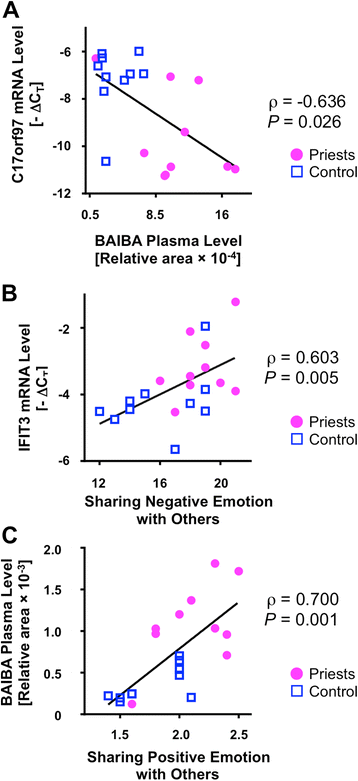Distinct transcriptional and metabolic profiles associated with empathy in Buddhist priests: a pilot study
- PMID: 28865488
- PMCID: PMC5581455
- DOI: 10.1186/s40246-017-0117-3
Distinct transcriptional and metabolic profiles associated with empathy in Buddhist priests: a pilot study
Abstract
Background: Growing evidence suggests that spiritual/religious involvement may have beneficial effects on both psychological and physical functions. However, the biological basis for this relationship remains unclear. This study explored the role of spiritual/religious involvement across a wide range of biological markers, including transcripts and metabolites, associated with the psychological aspects of empathy in Buddhist priests.
Methods: Ten professional Buddhist priests and 10 age-matched non-priest controls were recruited. The participants provided peripheral blood samples for the analysis of gene expression and metabolic profiles. The participants also completed validated questionnaires measuring empathy, the Health-Promoting Lifestyle Profile-II (HPLP-II), and a brief-type self-administered diet history questionnaire (BDHQ).
Results: The microarray analyses revealed that the distinct transcripts in the Buddhist priests included up-regulated genes related to type I interferon (IFN) innate anti-viral responses (i.e., MX1, RSAD2, IFIT1, IFIT3, IFI27, IFI44L, and HERC5), and the genes C17orf97 (ligand of arginyltranseferase 1; ATE1), hemoglobin γA (HBG1), keratin-associated protein (KRTAP10-12), and sialic acid Ig-like lectin 14 (SIGLEC14) were down-regulated at baseline. The metabolomics analysis revealed that the metabolites, including 3-aminoisobutylic acid (BAIBA), choline, several essential amino acids (e.g., methionine, phenylalanine), and amino acid derivatives (e.g., 2-aminoadipic acid, asymmetric dimethyl-arginine (ADMA), symmetric dimethyl-arginine (SMDA)), were elevated in the Buddhist priests. By contrast, there was no significant difference of healthy lifestyle behaviors and daily nutrient intakes between the priests and the controls in this study. With regard to the psychological aspects, the Buddhist priests showed significantly higher empathy compared with the control. Spearman's rank correlation analysis showed that empathy aspects in the priests were significantly correlated with the certain transcripts and metabolites.
Conclusions: We performed in vivo phenotyping using transcriptomics, metabolomics, and psychological analyses and found an association between empathy and the phenotype of Buddhist priests in this pilot study. The up-regulation of the anti-viral type I IFN responsive genes and distinct metabolites in the plasma may represent systemic biological adaptations with a unique signature underlying spiritual/religious practices for Buddhists.
Conflict of interest statement
Ethics approval and consent to participate
All participants were given a complete explanation of the study, which was approved on September 11, 2013, by the ethics committee of Tsukuba University of Technology (approval number TUT 20130911) and provided written informed consent. All participants were paid for their participation. During the study, the participants were asked a series of questions about their age, physical health, and medication use. Data from all participants was analyzed anonymously.
Consent for publication
Not applicable.
Competing interests
The authors declare that they have no competing interests.
Publisher’s Note
Springer Nature remains neutral with regard to jurisdictional claims in published maps and institutional affiliations.
Figures



Similar articles
-
Age, sex, and the association of chronic kidney disease with all-cause mortality in Buddhist priests: An analysis of the standardized mortality ratio from the Korean Buddhist priests cohort.Medicine (Baltimore). 2018 Nov;97(45):e13099. doi: 10.1097/MD.0000000000013099. Medicine (Baltimore). 2018. PMID: 30407320 Free PMC article.
-
Reflections of Buddhist priests who started a dementia carers' café in Japan.Dementia (London). 2022 Jul;21(5):1856-1868. doi: 10.1177/14713012221092212. Epub 2022 Apr 22. Dementia (London). 2022. PMID: 35452323
-
A vegetarian diet does not protect against nonalcoholic fatty liver disease (NAFLD): A cross-sectional study between Buddhist priests and the general population.Turk J Gastroenterol. 2015 Jul;26(4):336-43. doi: 10.5152/tjg.2015.0046. Epub 2015 Jun 2. Turk J Gastroenterol. 2015. PMID: 26039004
-
[Buddhist mummies in Japan].Kaibogaku Zasshi. 1993 Aug;68(4):381-98. Kaibogaku Zasshi. 1993. PMID: 8237299 Review. Japanese.
-
Self-perceived role and function of Christian prison chaplains and Buddhist volunteers in Hong Kong prisons.Int J Offender Ther Comp Criminol. 2013 Feb;57(2):154-68. doi: 10.1177/0306624X11432128. Epub 2011 Dec 19. Int J Offender Ther Comp Criminol. 2013. PMID: 22186880 Review.
Cited by
-
Lipid metabolism is associated with temperament, corticosteroid, and hematological measures in infant rhesus monkeys ( Macaca mulatta).Zool Res. 2020 Nov 18;41(6):709-714. doi: 10.24272/j.issn.2095-8137.2020.244. Zool Res. 2020. PMID: 33124219 Free PMC article.
-
Sense of Coherence as a Mediator in the Association Between Empathy and Moods in Healthcare Professionals: The Moderating Effect of Age.Front Psychol. 2022 Apr 25;13:847381. doi: 10.3389/fpsyg.2022.847381. eCollection 2022. Front Psychol. 2022. PMID: 35548503 Free PMC article.
References
-
- Loewenthal KM, MacLeod AK, Goldblatt V, Lubitsh G, Valentine JD. Comfort and joy? Religion, cognition, and mood in Protestants and Jews under stress. Cognit Emot. 2000;14(3):355–374. doi: 10.1080/026999300378879. - DOI
-
- Batson CD. Altruism in Humans. New York: Oxford University Press; 2011.
MeSH terms
LinkOut - more resources
Full Text Sources
Other Literature Sources
Medical
Research Materials

